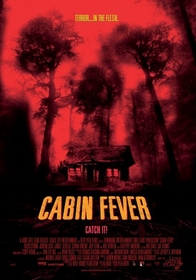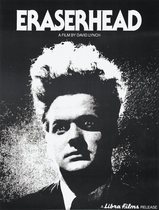Our editor-in-chief Nate Yapp is proud to have contributed to the new book Hidden Horror: A Celebration of 101 Underrated and Overlooked Fright Flicks, edited by Aaron Christensen. Another contributors include Anthony Timpone, B.J. Colangelo, Dave Alexander, Classic-Horror.com's own Robert C. Ring and John W. Bowen. Pick up a copy today from Amazon.com!
Cabin Fever (2002)
Eli Roth's directorial debut, Cabin Fever, serves as homage to road-trip horror films that calls to mind the numerous works that came before it (The Texas Chain Saw Massacre, The Hills Have Eyes, Evil Dead), and there exists a certain ironic disposition to the film since we, the audience, cannot help but think of all those other films instead of this one. Roth's mix of grotesque horror, bizarre humor, and sexual tension does work to give the film some of its own unique identity amongst other modern-day horror flicks, though the director's bits of ingenuity are not refined enough to pull the film out of mediocrity. This is not a particularly condemnable film, just one that has difficulty standing on its own since its framework is so worn from overuse.
For the five teenage friends of the film, a road trip to a solitary cabin in the middle of the woods is the ideal escape to relieve the stress of a post-exam college semester. Along the way the friends stop at a local general store and encounter some of the town's unusual locals, including a child named Dennis with a pension for biting out-of-towners. Despite the obvious warning signs that this town is not the kind of town to spend the night in, the friends arrive at their cabin sanctuary and all seems to be going well. Paul (Rider Strong), the nice guy of the group, makes a move on Karen (Jordan Ladd), the nice girl. Marcy (Cerina Vincent) and Jeff (Joey Kern), the couple, have lots of sex. Bert (James DeBello), the frat boy of questionable intelligence, is content to shoot squirrels and drink beer. But then a man covered in blood (Arie Verveen) staggers out of the woods, vomits all over the friends' truck, and kick-starts their terrifying battle against an airborne virus that infects the friends one by one.
To his credit, Roth wisely sidesteps the use of a physical villain to terrorize the teens, opting instead to rely on the paranoia of the characters as the film's main antagonist. One character is forced into a nearby shed and barricaded there when she begins to show signs of being infected. Meanwhile, the remaining characters bicker amongst themselves over who is and isn't infected, and this constant pointing of fingers creates a rift that generates a great amount of tension not only within the cabin, but the film itself. Even better, the paranoia is slightly misplaced; the friends believe the infection is caused from coming in contact with the stranger from the woods when in actuality, the virus is in the water supply.
Roth carries much of this tension into his particularly gory scenes, the most infamous of which involves a female character shaving her legs in a bathtub. Given that the actual act of shaving involves delicate strokes of a razor, it's no surprise that Roth's camera moves at a gradual pace up and down the girl's bare leg until we see that she's no longer shaving her leg but a bleeding scab. It's one of the film's most cringe-inducing and memorable scenes because of the tension that's involved with Roth's camera movements. That the character is nude during the scene presents her with an unmistakable vulnerability as well, which serves to heighten the tension.
It is disappointing, however, to witness the lack of subtly that Roth uses when filming the actual infection of his characters, as this could have been a great source of suspense within the film. After the friends accidentally kill the stranger covered in blood and dump him into a nearby reservoir, the camera steadies on the body floating in the water, then it tracks to a pipe leading from the water where it is followed to the cabin. As if the audience still hasn't a clue what Roth is attempting to convey, there is a cut to a close-up of a faucet where Paul is getting a glass of water. Each time a character drinks from a glass of water thereafter, a haunting note strikes the soundtrack, as if to tell the audience, "this is bad." Had the audience not discovered the true source of the infection until the characters do (about ¾ into the movie), the suspense could have lingered throughout most of the film. Instead, we know exactly when a character becomes infected, so we're constantly in the know of who is the next to kick the bucket.
Also disappointing is Roth's misuse of his supporting characters, writing them in at opportune moments and then plucking them from the screen too soon. One example of this comes just after the teens have killed the stranger from the woods and Bert and Jeff, looking for help, come across a woman who invites the two into her home. Once inside, the two realize that the man they killed is the cousin of this woman, and the conflict that this scene could have generated goes unrealized since the two boys just leave the house and the woman is never seen or heard from again. That same disappointment is shared when Deputy Winston -- easily the film's most brain-dead character --arrives at the cabin. During a time in which the audience wonders whether or not the teenagers will get blamed for the stranger's death, Winston just provides poor comic relief and demolishes the potential suspense. There's nothing even slightly humorous about him; not his pension for calling Paul "son" (the two appear to be about the same age), not his constant use of the word "party," and certainly not the fact that he rides a bike with a bell on it. If the bike had a basket on it, maybe I'd snicker.
Cabin Fever is the kind of movie that provides one or two memorable scenes of gore that we have to run out and tell our friends about, but there's no reason to recommend the film as a whole. There are far better films out there -- ones that feel similar to this one and can compel us with their characters, suspense, conflict, tension, and plot. Roth has attempted to convey that sense of appreciation toward such films with his first outing as a director, and while he has successfully reminded his audience of those other films, the director's own stamp is far too faint to turn the film into something wholly original.








